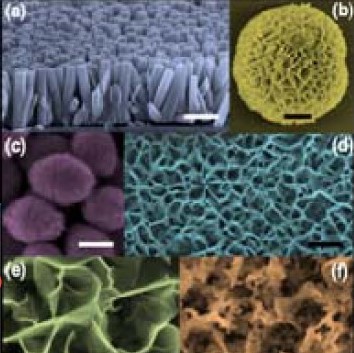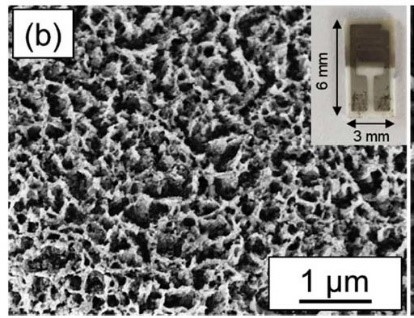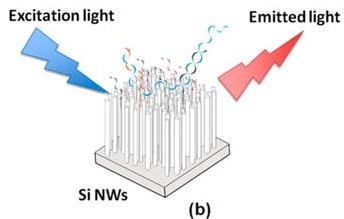Sensors
 Sensors play an essential role in numerous sectors of interest for the Internet of Things, from home automation to automotive, biomedical engineering to the food and packaging sector or even precision agriculture. The physics of matter contributes to the understanding of microscopic phenomena underlying the detection mechanism and reveals the interactions that occur at the interface between the sensitive material and the surrounding environment. The long experience of the group in the physics of materials and the consolidated experience in controlling their morphology and their dimensions, has allowed to develop innovative nanostructures applied in simple demonstration devices with high performance.
Sensors play an essential role in numerous sectors of interest for the Internet of Things, from home automation to automotive, biomedical engineering to the food and packaging sector or even precision agriculture. The physics of matter contributes to the understanding of microscopic phenomena underlying the detection mechanism and reveals the interactions that occur at the interface between the sensitive material and the surrounding environment. The long experience of the group in the physics of materials and the consolidated experience in controlling their morphology and their dimensions, has allowed to develop innovative nanostructures applied in simple demonstration devices with high performance.
Electrochemical Sensors
.jpg)
Faculty: E. Bruno, M.G. Grimaldi, S. Mirabella, F. Priolo, F. Ruffino, A. Scandurra
Electrochemical sensing techniques are very versatile and at the same time low energy consumption. These techniques, combined with the use of nanostructured electrodes of transition metal oxides (such as ZnO, NiO, CuO, WO3) made with laser ablation in liquid (PLAL) or with low-cost methods such as chemical and hydrothermal bath syntheses , allow to obtain extremely competitive and low environmental impact sensors for applications both in the biomedical field (glucose, pH or DNA sensors) and environmental (for example heavy metal sensors). Particular importance is given to the study and development of combined nanostructured materials (eg bi- or trimetallic clusters) with motion properties relevant for catalysis.
Gas Sensors

Faculty: E. Bruno, S. Mirabella, F. Priolo, F. Ruffino, M.C. Spadaro
Gas sensors are used in sectors ranging from air quality control to food freshness control to the diagnosis of diseases. In particular, the chemoresistive sensors, made mainly with nanostructured semiconductor metal oxides (ZnO, WO3, CuO ...), obtained both with low-cost techniques such as chemical and hydrothermal bath synthesis and with laser ablation in liquid, are characterized by very high sensitivity towards a very large class of gases and vapors (such as NO, CO, H2, NO2, etc.), are very compact and economical and require very little maintenance. Some of these activities benefit from studies by transmission electron microscopy to obtain information about their atomic arrangement, structure and composition at atomic resolution thanks to a collaboration agreement with the Institut Català de Nanociència i Nanotecnologia (ICN2) in Catalonia (Spain).
Optical Sensors for biomedical applications

Faculty: M.R. Chiechio, M. J. Lo Faro, P. Musumeci, F. Priolo
Optical sensors base their operation on the conversion of light rays into an electronic signal. They can be used in many fields ranging from simple distance sensing to biological material sensing allowing versatile, fast, non-destructive and highly sensitive measurements. The combination of the experience in silicon-based photonics and the ability to create such materials in nanostructured form has allowed us to obtain cutting-edge results. Recently, the quantum fluorescence properties of ultrascale gold nanoclusters have been used to produce an ultrasensitive and selective optical sensor for the detection of DNA sequences reaching attomolar LOD. This type of systems also find application in quantum sensing with applications in advanced diagnostics.
Sensors for textile electronics
.jpg)
Faculty: F. Torrisi
Sensors integrated into the tissues capable of monitoring body parameters, movement or protecting the user from heat and cold are extremely important in the field of health monitoring and protection in the workplace. The research group has developed a state-of-the-art platform of motion, thermal and biochemical sensors that can be printed on fabrics and can be integrated with textile fibers based on two-dimensional materials and biocompatible semiconductor polymers.
Intelligent micro- and nanorobots
Faculty: M. Urso, S. Mirabella
Micro- and nanorobots represent a new frontier in advanced sensing: they can interact with their surrounding environment, detect physical or chemical stimuli, such as light, magnetic fields, or specific molecules, and convert them into energy to move and activate sophisticated functions. Made from responsive materials and built using bottom-up techniques inspired by nature, they feature adaptive and multifunctional structures. Their cooperative behavior in swarms enhances their ability to explore, diagnose, and operate in complex environments. Applications range from medicine to environmental monitoring.